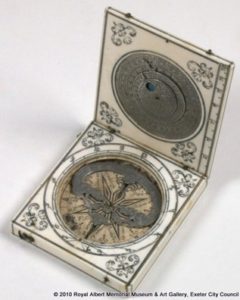This pocket azimuth sundial has been in RAMM’s collection since 1873 and can be found in the museum’s courtyard area. It was created by Charles Bloud in Dieppe, Northern France around 1670 and served as a portable solar watch.

Pocket sundials became particularly popular for timekeeping between the 15th and 19th centuries. They had both functional and decorative purposes. As well as helping to keep busy people on schedule, these objects had a symbolic value. They projected the tastes and wealth of their owners. Craftsmen such as Bloud expressed their artistic skills and ingenuity of design in these fashionable and functional items. On this example, delicate silver dials have been embedded within an ivory case, engraved with swirling floral decoration.
The magnetic azimuth sundials made by Bloud were not only portable, but also designed to work at multiple latitudes. This would accommodate the needs of merchants, pilgrims and other long-distance travellers. With Bloud’s sundial, the traveller could determine the time by orienting the sun’s shadow along a specified line on the sundial. They could then read the hour indicated by a needle on the in-built compass.
This content is viewable by members only. Login or sign up to get access.

